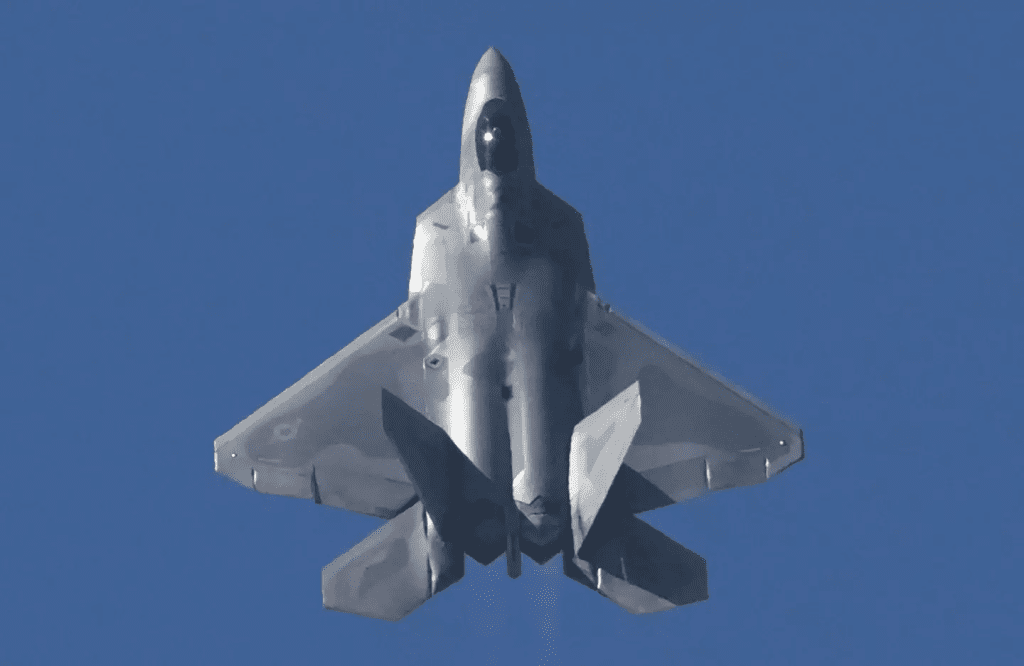A recent video of an F-22 Raptor fighter jet has taken the internet by storm, with many viewers stunned by what appears to be the aircraft activating its ‘cloaking device.’ While the footage may look like a scene from a sci-fi movie, the reality behind the phenomenon is rooted in fascinating aerodynamics and physics.

What’s Happening in the F-22 Raptor ‘Cloaking Device’ Footage?
The viral video, captured by photographer and videographer Mark Fingar, shows an F-22 Raptor near the moment it is about to break the sound barrier. In the footage, the jet becomes enveloped in a mysterious vapor cone that makes it appear to vanish—leading many to humorously describe it as the activation of a ‘cloaking device.’
However, what is actually happening here is a result of physics rather than a high-tech invisibility feature. When the F-22 approaches the speed of sound, a sudden and dramatic shift in air pressure causes the formation of a vapor cone around the jet.

The Science Behind Vapor Cones
Vapor cones occur when an aircraft is flying through moist air at high speeds, causing the local air pressure around the jet to drop rapidly. As the air pressure drops, the temperature also falls, reaching a point where water vapor in the air condenses and forms a visible cloud around the jet. This effect is often mistaken for a ‘cloaking’ phenomenon, especially when the aircraft seems to disappear momentarily.
Rod Irvine, the chairman of the Royal Aeronautical Society’s aerodynamics group, explained the science to the BBC: “If you see a vapor cone, you’ve got a shockwave, because you’ve got a change in pressure and temperature.” He further clarified that the aircraft itself may not be traveling faster than the speed of sound, but the air over the wings is moving fast enough to locally break the sound barrier, creating the shockwave and the resulting vapor cone.
F-22 Raptor: A High-Speed Marvel
The Lockheed Martin F-22 Raptor, known for its advanced technology and stealth capabilities, was first introduced in 1997. While once considered one of the most advanced fighter jets ever developed, the F-22’s future was uncertain. In 2021, it was believed that the aircraft might be retired by the end of the decade. However, recent decisions to upgrade the fleet suggest that the F-22 Raptor may remain in service into the 2030s.
The F-22 is capable of reaching speeds of up to 1,500 mph (2.2 times the speed of sound), burning approximately 5,000 pounds of fuel per hour. With such impressive performance, it’s no wonder the jet has captivated onlookers and aviation enthusiasts worldwide.

Social Media Reactions: ‘Cloaking Device’ Comparisons
The F-22’s vapor cone phenomenon has sparked a flurry of reactions on social media. Many users humorously compared the jet’s vapor cone to scenes from popular movies. One Twitter user wrote: “Mark Fingar captured an F-22 Raptor activating its cloaking device,” while another playfully referenced a Harry Potter comparison. “It’s how they play peekaboo in the clouds,” joked yet another commenter.
Despite the playful comments, the science behind vapor cones is genuinely fascinating. The formation of the vapor cone demonstrates the complex and impressive physics that occur when an aircraft like the F-22 Raptor pushes the limits of speed and aerodynamics.
Conclusion: Why Vapor Cones Look Cool
While the F-22 Raptor doesn’t come equipped with a cloaking device, its vapor cone effect certainly looks like something straight out of a sci-fi thriller. Whether it’s the jet’s speed, the sudden shift in air pressure, or the resulting shockwave, the effect is undeniably impressive. For aviation enthusiasts and casual viewers alike, the phenomenon serves as a reminder of the incredible capabilities of modern fighter jets.
So, the next time you see a fighter jet seemingly vanish into thin air, you’ll know that it’s not magic or a cloaking device—just the awe-inspiring science of high-speed flight at work.


